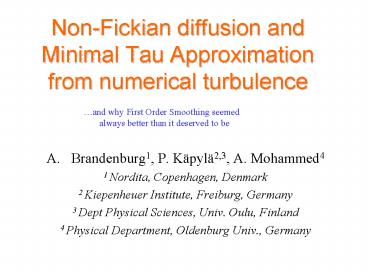NonFickian diffusion and Minimal Tau Approximation from numerical turbulence - PowerPoint PPT Presentation
1 / 18
Title:
NonFickian diffusion and Minimal Tau Approximation from numerical turbulence
Description:
Non-Fickian diffusion and Minimal Tau Approximation from numerical turbulence ... Electromotive force (astrophysics) Effects of stratification, Coriolis force, B-field ... – PowerPoint PPT presentation
Number of Views:65
Avg rating:3.0/5.0
Title: NonFickian diffusion and Minimal Tau Approximation from numerical turbulence
1
Non-Fickian diffusion and Minimal Tau
Approximation from numerical turbulence
and why First Order Smoothing seemed
always better than it deserved to be
- Brandenburg1, P. Käpylä2,3, A. Mohammed4
- 1 Nordita, Copenhagen, Denmark
- 2 Kiepenheuer Institute, Freiburg, Germany
- 3 Dept Physical Sciences, Univ. Oulu, Finland
- 4 Physical Department, Oldenburg Univ., Germany
2
MTA - the minimal tau approximation
- 1) replace triple correlation by quadradatic
- 2) keep triple correlation
- 3) instead of now
- 4) instead of diffusion eqn damped wave equation
(remains to be justified!)
i) any support for this proposal?? ii) what is
tau??
3
Purpose and background
- Need for user-friendly closure model
- Applications (passive scalar just benchmark)
- Reynolds stress (for mean flow)
- Maxwell stress (liquid metals, astrophysics)
- Electromotive force (astrophysics)
- Effects of stratification, Coriolis force,
B-field - First order smoothing is still in use
- not applicable for Re gtgt 1 (although it seems to
work!)
4
Testing MTA passive scalar diffusion
primitive eqn
fluctuations
Flux equation ? triple moment
MTA closure
gtgt1 (!)
5
System of mean field equations
mean concentration
flux equation
Damped wave equation, wave speed
(causality!)
gtgt1 (!)
6
Wave equation consequences
- late time behavior unaffected (ordinary
diffusion) - early times ballistic advection (superdiffusive)
Illustration of wave-like behavior
small tau
large tau
intermediate tau
gtgt1 (!)
7
Comparison with DNS
- Finite difference
- MPI, scales linearly
- good on big Linux clusters
- 6th order in space, 3rd order in time
- forcing on narrow wavenumber band
- Consider kf/k11.5 and 5
8
Test 1 initial top hat function
Monitor width and kurtosis
black closure model red turbulence sim.
Fit results kf/k1 Sttukf 1.5
1.8 2.2 1.8 5.1 2.4
9
Comparison with Fickian diffusion
No agreement whatsoever
10
Spreading of initial top-hat function
11
Test 2 finite initial flux experiment
but with
Initial state
black closure model red turbulence sim.
Dispersion Relation Oscillatory for k1/kflt3
? direct evidence for oscillatory behavior!
12
Test 3 imposed mean C gradient
Convergence to St3 for different Re
gtgt1 (!)
13
kf5
14
kf1.5
15
Comment on the bottleneck effect
Dobler et al (2003) PRE 68, 026304
16
Bottleneck effect 1D vs 3D spectra
17
Relation to laboratory 1D spectra
Parseval
used
18
Conclusions
- MTA viable approach to mean field theory
- Strouhal number around 3
- FOSA not ok (requires St ? 0)
- Existence of extra time derivative confirmed
- Passive scalar transport has wave-like properties
- Causality
- In MHD, ltj.bgt contribution arrives naturally
- Coriolis force inhomogeneity straightforward































